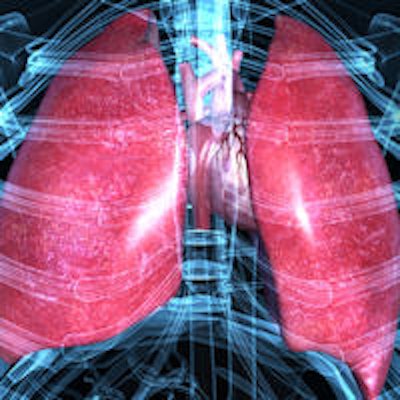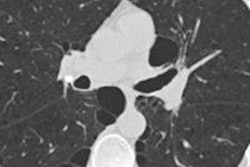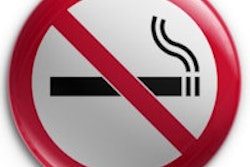
The costs of population-wide CT lung cancer screening are likely to be reasonable and comparable to the costs of breast or colon cancer screening, according to an article in the May edition of Thoracic Surgery Clinics.
The study, based largely on data from the National Lung Screening Trial (NLST), builds on previous lung cancer screening cost-effectiveness research by focusing on the factors most likely to affect costs, wrote Dr. David Mauchley and Dr. John Mitchell from the University of Colorado. While the analysis pegs the total cost of screening at $2 billion to $4 billion per year, the benefits of screening meet generally accepted thresholds for an effective screening test.
And as CT technology advances and smoking cessation programs are implemented going forward, CT lung cancer screening should achieve an even more favorable profile, the authors added (Thorac Surg Clin, May 2015, Vol. 25:2, pp. 205-215).
A raft of research
In their analysis, the researchers summarized previous cost estimates for CT lung cancer screening, estimated current annual costs in the U.S. under a widespread screening program, identified factors with the greatest effects on cost, and reviewed future issues related to implementing CT screening nationally.
Since CT screening's 20% mortality benefit became known through NLST, a raft of research studies have sought to estimate screening's cost-effectiveness in a variety of hypothetical screening cohorts, the authors wrote. All have sought to position CT lung screening against the generally accepted benchmark of $50,000 per quality-adjusted life year (QALY) that represents a cost-effective test -- exams higher than that level are considered less efficient.
For example, Marshall et al in 2001 showed a cost of $5,940 for one-time screening (QALY was not calculated). Importantly, more than 80% of screening subjects with cancer detected on CT screening had curable stage I tumors, Mauchley and Mitchell wrote. Extrapolating the single scan to a program of screening over five years raised the screening cost to $88,268 per life year saved in 2014 dollars.
In contrast, two simulation modeling studies published in a similar time period found that screening with CT was unlikely to be cost-effective. Mahadevia et al calculated incremental cost-effectiveness at $116,300 per QALY gained in current smokers, a figure the study's authors said could be reduced to $42,500 only by applying the most favorable cost assumptions.
Similarly, an Australian study concluded that screening male heavy smokers could be held under $50,000 per QALY only if screening brought a 20% reduction in lung cancer-specific mortality.
For their part, McMahon et al used cohorts of different ages and smoking histories. They found the cost of annual screening to be more than $100,000 per QALY regardless of smoking history.
Then, Villanti et al concluded that with intensive smoking cessation programs, the cost could be brought down to $16,198 per QALY gained. Meanwhile, Goulart et al estimated the cost of implementing screening in the U.S. using NLST cohort data, and concluded that although 8,000 lives could be saved each year with screening, avoiding a single lung cancer death would cost $240,000.
New study based on NLST
In their study, Mauchley and Mitchell started with data from the U.S. Census and the U.S. Centers for Disease Control and Prevention (CDC) to estimate the number of eligible screening subjects in the 55- to 74-year-old cohort, stratifying subjects by decade of birth to estimate pack years.
The researchers then calculated the number of patients with a positive CT scan by multiplying the proportion of NLST subjects with a positive scan in the second year of screening by the number of eligible screening subjects. This result was multiplied by the false-positive rate of 96.4% from NLST to assess the number of false positives.
Recent Medicare data were used to calculate treatment costs. Cost per death avoided was calculated as the costs of screening divided by the 320 cancer deaths avoided per year in NLST. Life years gained were based on cancer stage at diagnosis.
Overall, under their model, just 3.5% of the population (2,258,662 people) would be heavy smokers eligible for screening, and 5.8% (3,742,925 individuals) would be considered former heavy smokers, for a total of 6,001,587 eligible individuals, of whom about 1% would have true positive results from lung cancer screening.
They calculated that total costs of screening and follow-up exams ranged from $2.4 billion if 50% of all eligible individuals are screened to $4.8 billion if everyone eligible gets exams. The costs attributable directly to CT scanning represent 75% of total costs across all screening rates, the authors wrote.
The researchers then calculated the cost-effectiveness of CT screening based on three different screening rates of the population eligible for the exams under NLST criteria.
| Cost-effectiveness of CT lung cancer screening by rate | |||
| 100% screen rate | 75% screen rate | 50% screen rate | |
| Cost per lung cancer death avoided | $183,535 | $178,196 | $183,577 |
| Life years saved by screening | 120,792 | 90,596 | 60,408 |
| Cost per life year saved | $28,497 | $27,667 | $28,496 |
| Cost per QALY saved | $35,577 | $34,540 | $35,576 |
"This [$35,000 QALY] value is slightly higher than that for breast and colon cancer but is considerably less than the historically accepted cost of $50,000 per life year gained used to determine the cost-effectiveness of screening examinations," Mauchley and Mitchell wrote.
That said, there are many ways that total costs of up to $3.4 billion could be reduced, the group noted. For example, a chest CT scan cost of $527 was used for the calculations, but other studies have used a figure of $150, which would reduce screening costs to less than $900 million per year. A more reasonable $250 per scan would lead to screening costs of about $1.5 billion annually.
A $250 per scan cost "would mean that the cost per lung cancer death avoided would come down to $83,000 and the cost per life year gained would be $13,000, putting screening with [low-dose CT (LDCT)] at a level of cost-effectiveness that is on par with screening for breast and colon cancer," Mauchley and Mitchell wrote.
Based on NLST results in more than 50,000 individuals, "we are certain that some lung cancer deaths can be prevented with LDCT screening," the team concluded. "Given the degree to which this occurred in the trial, widespread use of LDCT screening is likely to occur. The cost of implementing such a screening program is likely to be considerable, but remains unknown."
However, "as CT scanning technology improves and best-practice guidelines for follow-up are established, this cost is likely to come down, making LDCT a cost-effective method of preventing lung cancer death in the United States," they wrote.




















